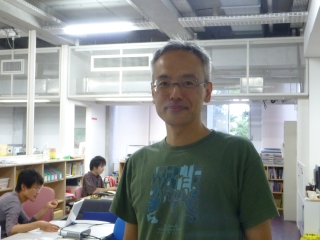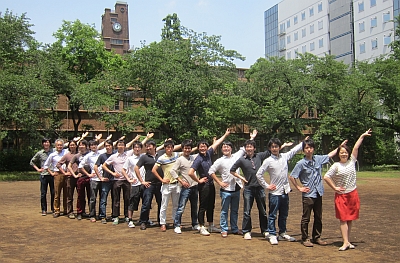- HOME
- NEWS
- RCAST Report
- Congratulations on the 11th Leo Esaki Prize!
Congratulations on the 11th Leo Esaki Prize!
- RCAST Report
September 9, 2014
On September 2, 2014, Professor Yasunobu Nakamura was honored with the 11th Leo Esaki Prize. We asked Professor Nakamura about the prize and his future research in RCAST.

Professor Yasunobu Nakamura
-
Leo Esaki Prize
The prize is presented to the researcher for outstanding achievements in the field of "Nanotechnology," the science of characterizing, manipulating, and utilizing a matter in the scale of nanometers: One nanometer is a millionth of a millimeter, or a size of a few tens of atoms. The prize is funded by the foundation in which Dr. Leo Esaki, a Nobel laureate in physics, is a chairman of the board of directors.
Congratulations on receiving the Leo Esaki Prize.
Could you briefly explain the research which you received the award for: "Research on Superconducting Quantum Bit Systems"?
Dr.Nakamura:
In this research we demonstrated a "quantum bit" (note 1), which is expected to be an important component of a future quantum computer, by using an electric circuit made of a material without electrical resistance, called superconductor. Our first success in 1999 attracted a lot of attention because a quantum bit using a solid-state device had never been reported prior to that.
(Note 1) Quantum bit: the minimum unit of information treated by a quantum computer. While a classical bit only represents 0 or 1 at a time, the quantum bit can take a special state called a superposed state where 0 and 1 are sort of coexisting. Therefore, compared with the classical information processing, there is a markedly greater quantity of information which can be treated at once with a quantum computer.
What kind of research is it?
We sometime explain it with the phrase "an artificial atom", instead of "a quantum bit". In nature, an atom consists of a nucleus surrounded by electrons. The electrons of an atom are bound to the nucleus, and the energy levels of the electrons are discontinuous. This was the first description of an atom based on quantum mechanics about 100 years ago.
Our research similarly creates discrete energy levels in a superconducting circuit. We label the lowest energy state and the second lowest, 0 and 1, and use them as a "quantum bit." This circuit can be treated as a "quantum bit" from the viewpoint of information processing, but the same circuit can also be seen as an "artificial atom" from a physicist’s point of view.
Our research with a superconducting circuit takes a similar approach by Dr. Haroche and Dr. Wineland, who won the Nobel Prize for physics in 2012 (note 2) for their works on manipulations of single natural atoms in a quantum manner. However, the difference is in the use of artificial atoms realized in circuits with unprecedented design freedom and versatility; unlike atoms in nature, our artificial atoms have variety of tuning parameters. We are currently investigating the interaction between an artificial atom and microwave photons (note 3).
(Note 2) They were awarded the prize for "ground-breaking experimental methods that enable measuring and manipulation of individual quantum systems". The Nobel Prize in Physics 2012 (http://www.nobelprize.org/nobel_prizes/physics/laureates/2012/)
(Note 3) Microwaves are electromagnetic waves, as is light; "a microwave photon" can be considered as a quantum of an electromagnetic wave.
Is the "superconductivity quantum bit" being studied in RCAST now?
Yes, we are continuing the activities. Meanwhile, we are studying something new as well.
At first, I started the research on quantum mechanics based on my personal interest. Quantum mechanics is well known to govern the physics of the small-scale world, such as that of an atom, but we cannot perceive it in our everyday life. Theoretically, quantum phenomena should be observed in any physical scale. It was my genuine interest to understand why quantum phenomena are not recognized in the visual scale. Our research on the superconductivity quantum bit was able to answer some of these questions.
Our "quantum bit" circuit is about 1 mm square in size, the size you can easily see with your naked eyes. Although the quantum-mechanical behavior is not visible there, we can confirm by using electrical measurements that it is operating perfectly in the quantum mechanical manner. We now have a way of controlling our circuit, which is much larger than a natural atom, in the quantum manner. The next step is to control other physical systems by using superconducting circuits as a tool and to let them manifest effects of quantum mechanics, too.
What are “other physical systems” you have in mind? Can you give an example?
One is "nanomechanics", the oscillating motions of a nanoscale cantilever or a thin membrane fabricated with semiconductor nanofabrication technology. Nanomechanics is an active research area and a lot of research is being conducted all over the world now. The latest research showed the quantum mechanical behavior of a nanomechanical system which is much heavier than an atom.
Another is quantum control of a ferromagnet, which is a completely new idea developed in our lab as a quantum system. The behavior of a millimeter-scale magnet can also be controlled in a quantum mechanical way. We are developing methods to control the quantum state of a magnet using a superconducting circuit. We succeeded in the first attempt, and the results were just published last month.
One of the reasons for aiming the quantum control of nanomechanical devices or ferromagnets is the development of the quantum interface. In order to realize a quantum information network between two or more remote superconducting quantum computers, quantum information must be exchanged through a fiber-optical network between them. If light strikes a superconducting quantum bit, however, the superconducting state of the quantum bit breaks down, because an optical photon has much higher energy than that allowed in superconducting circuits. Therefore, we need something in between the light and the superconducting circuit as an interface. Both nanomechanical devices and ferromagnets are a candidate for that.
Can you describe your future research in a single phrase?
"Be a master of quantum!"
This is the slogan of our laboratory tour at the Komaba research campus open house. In classical physics, many of the predicted phenomena can usually be perceived by us. Quantum phenomena, however, is beyond our recognition, right? There are a lot of mysteries with the quantum world. For example, a recent research on photosynthesis in plants has shown evidence of a quantum-mechanical effect playing a role in raising the energy-harvesting efficiency. There remain many open questions before we understand our universe in the level of quantum mechanics.
In the past, quantum mechanics was known for describing the operational principle of the semiconductor devices. Currently, the application of the quantum mechanics in the field of information science has been receiving a lot of attention. Using the quantum nature to enhance the power of information processing is one of the emerging ideas. All the researchers in our field can be considered as quantum engineers, who hope to develop technology which will be able to take advantage of quantum mechanics to push the limit further.
Researchers interested in quantum mechanics are gathered in my laboratory, but they have completely different backgrounds and experimental techniques. I’m enjoying discussing quantum mechanics with them, aspiring to become "a master of quantum" who handles quantum mechanics at will.

Researchers in Nakamura-Usami Group.
Be a master of quantum!!
Tags


